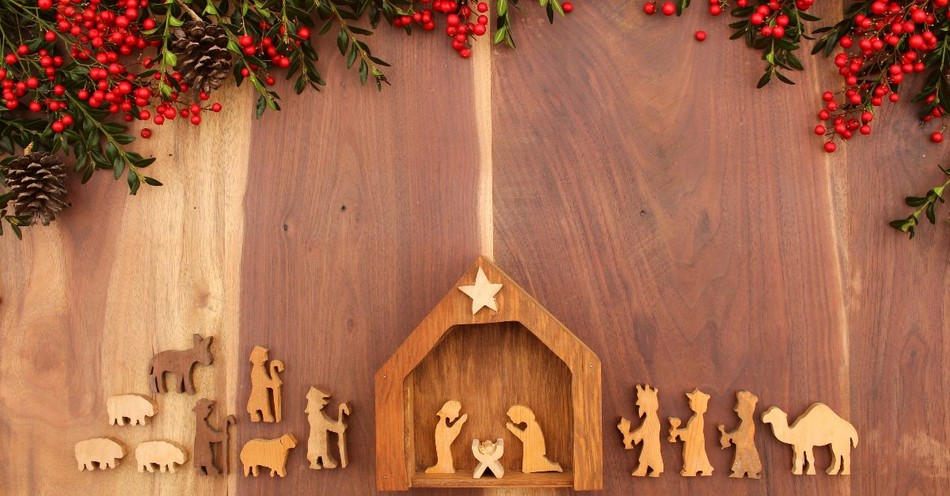Our Christmas celebrations started with my mom retelling the Christmas story as we set up a small nativity scene. We first put a rustic stable about the size of a shoebox that mom called a creche on a table.
Next, we added small figurines of wise men, shepherds, an angel or two, Mary, Joseph, and the baby Jesus in a manger surrounded by hay. This was a special tradition for my family that has roots dating back nearly 800 years.
Appreciating this Christian practice starts with understanding the meaning of "nativity" and exploring the questions, "Can the word ‘Nativity’ be found in the Bible?” and "How did the Nativity tradition begin?" First, let's start with the meaning of “nativity.”
What Does the Word ‘Nativity’ Mean?
According to the Merriam-Webster Dictionary, nativity means "the process or circumstances of being born: birth" and "especially, capitalized: the birth of Jesus." Merriam-Webster also explained the origins of this word, "Nativity is one of many words born of the Latin verb nasci, which means 'to be born.'”
The gestation of the word was a long one. "Nasci" developed in Latin into nativitas, meaning “birth,” which passed through Middle French as nativité before entering English in the 14th century."
The Oxford dictionary from Lexico.com added other English meanings, including "picture, carving, or model representing Jesus Christ's birth, a nativity play, and the Christian festival of Christ's birth; Christmas." Bible dictionaries may include entries about the "Nativity of Christ."
For example, the "Nativity of Christ" entry from Easton's Bible Dictionary in 1897 explains, "The birth of our Lord took place at the time and place predicted by the prophets (Genesis 49:10; Isaiah 7:14; Jeremiah 31:15; Micah 5:2; Haggai 2:6-9; Daniel 9:24; Daniel 9:25). Joseph and Mary were providentially led to go up to Bethlehem at this period, and there Christ was born” (Matthew 2:1; Matthew 2:6; Luke 2:1; Luke 2:7).
In modern dictionaries like the Holman Illustrated Bible Dictionary, the "Nativity of Christ" entry directs the reader to "see Jesus Christ: Jesus, Life, and Ministry."
Can the Word ‘Nativity’ Be Found in the Bible?
The quick answer to this question is yes, with a caveat. The word "nativity" is in several translations of the Bible. However, it is not used in the Bible to refer to the birth of Jesus. According to BibleStudyTools.com, "nativity" can be found 81 times in various translations of the Old and New Testaments and Apocrypha.
It is most commonly seen in the oldest translations of the Bible, including the Wycliffe Bible written in 1382, Douay-Rheims Catholic Bible from 1582, The King James Version Bible in 1611 (and updated versions of the King James), The Webster Bible from 1833, The Darby Translation (First translated in 1890 and last updated in 1961), and American Standard Version from 1901.
In the New Testament, the word "nativity" is found in the angel's message to Zacharias in Luke 1:14, "And thou shalt have joy and gladness: and many shall rejoice in his nativity" in both the Wycliffe Bible and Douay-Rheims Catholic Bible.
However, modern translations of this verse don't use the word "nativity" but instead, use the word "birth." It is also found in James 3:6, "And the tongue is a fire, a world of iniquity. The tongue is placed among our members, which defileth the whole body and inflameth the wheel of our nativity, being set on fire by hell" in the Douay-Rheims Catholic Bible version.
1. So, why do we call Jesus' birth the Nativity if it isn't in modern translations of the Bible? How did the Nativity tradition begin? The use of nativity goes back many centuries to when it was commonly used to describe birth.
Both the name and the tradition have lasted over 700 years. Some people date the first Nativity scene to 1223 when St. Francis of Assisi staged a living Nativity in a cave near Greccio, Italy. Thomas of Celano recorded St. Francis' desire to reenact the birth of Christ just before Christmas in his book, The Life of St. Francis, written in 1229. Francis said,
"Hurry before me and carefully make ready the things I tell you. For I wish to enact the memory of that babe who was born in Bethlehem: to see as much as is possible with my own bodily eyes the discomfort of his infant needs, how he lay in a manger, and how, with an ox and an ass standing by, he rested on hay."
2. What is the connection between Christmas pageants, cribs, and creches? St. Francis' early interactive Mass has morphed over the past seven centuries into our modern Christmas pageants and living Nativity scenes.
In addition to church services that reenacted the Christmas story with live animals, other towns and villages began to re-create the first Christmas using life-size mannequins of Mary, Jesus, Joseph, the wise men, and shepherds.
Artists made miniature versions of the Nativity scene that people could set up in their own homes. These smaller scenes are also called many different names, including Christmas crib, crèche, manger scene, Bethlehem scene, Praesepe (Latin for manger), or Presepio (Italian for a crib.).
"By the dawn of the baroque era, the crib setting had become an intricate scenic landscape, and numerous secular figures were now added to those of the Holy Family, shepherds and Magi. Crib-making thus developed into an important folk art" (New Catholic Encyclopedia, Volume IV).
Continuing the Nativity Tradition
The tradition of the Nativity has continued for nearly 800 years because it enabled the Word of God to come alive to those who could not read in the 13th century, enthralled small children through the centuries, and still inspires us today. Seeing a creche helps us imagine the angel from Luke 2:10-12 saying to shepherds in the field,
"Do not be afraid. I bring you good news that will cause great joy for all the people. Today in the town of David a Savior has been born to you; he is the Messiah, the Lord. This will be a sign to you: You will find a baby wrapped in cloths and lying in a manger."
Setting up a creche in your home or reenacting the story of Christ's birth from Luke 2 with other people and animals is a great way to participate in an ancient Christian tradition. For example, my husband and I share the Christmas story with our family using an unbreakable kid-friendly Nativity scene.
A church in our town re-creates a "Night in Bethlehem" complete with camels, donkeys, and an innkeeper who loudly proclaims, "No room at the inn." Nativity scenes juxtapose the reality of hay and animals with the miracle of Christmas.
Though much has changed in our world since that first night in Bethlehem when the angels proclaimed, "Glory to God in the highest heaven, and on earth peace to those on whom his favor rests," we can all celebrate the joy and peace of that first Christmas by making this ancient tradition our own.
Sources
St. Bonaventure [Francis of Assisi, The Founder, Early Documents, Vol. II, 2000, Editors: Armstrong, Hellmann, Short.
For further reading:
What Do We Know about the Shepherds at Jesus’ Birth?
What Is the Full Story of Jesus’ Birth?
What Is the Significance of the Star of Bethlehem?
What Is the Significance of the Three Wise Men and Their Gifts?
Photo Credit: ©iStock/Getty Image Plus/sjarrell
Penny Noyes, M.Ed. is the author of Embracing Change - Learning to Trust God from the Women of the Bible and two books about Hezekiah. You can follow Penny on her blog and on Instagram @pennynoyes.


.jpg)
